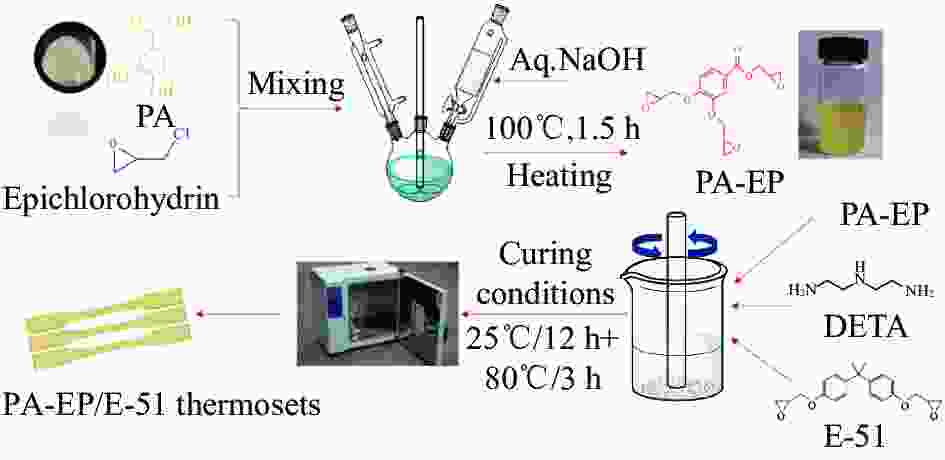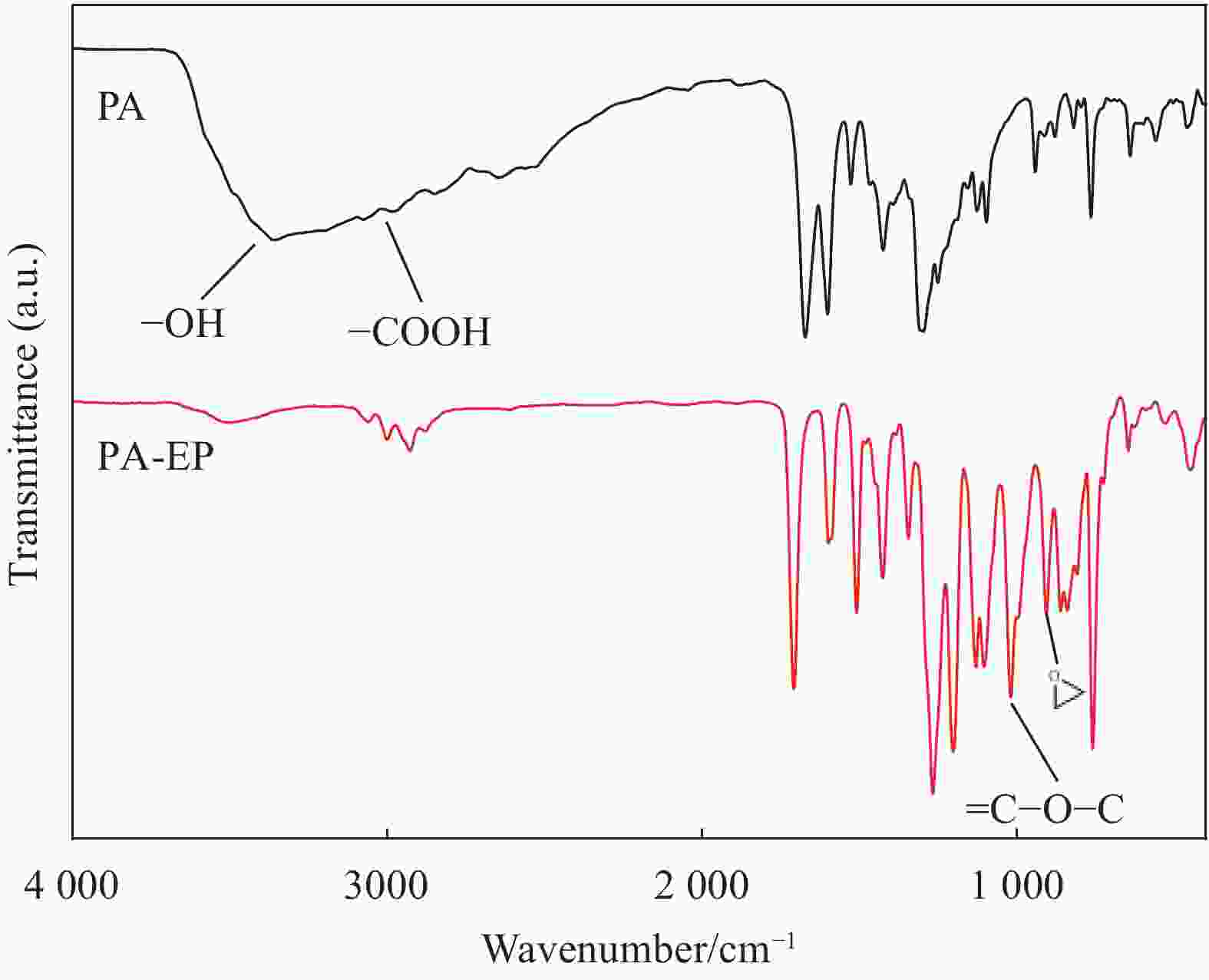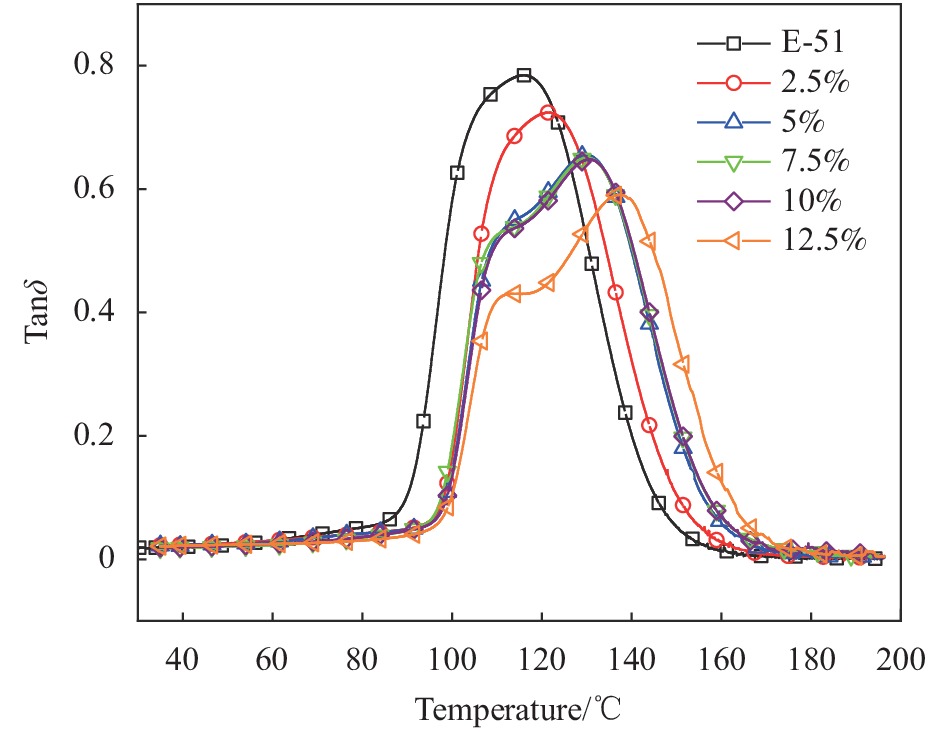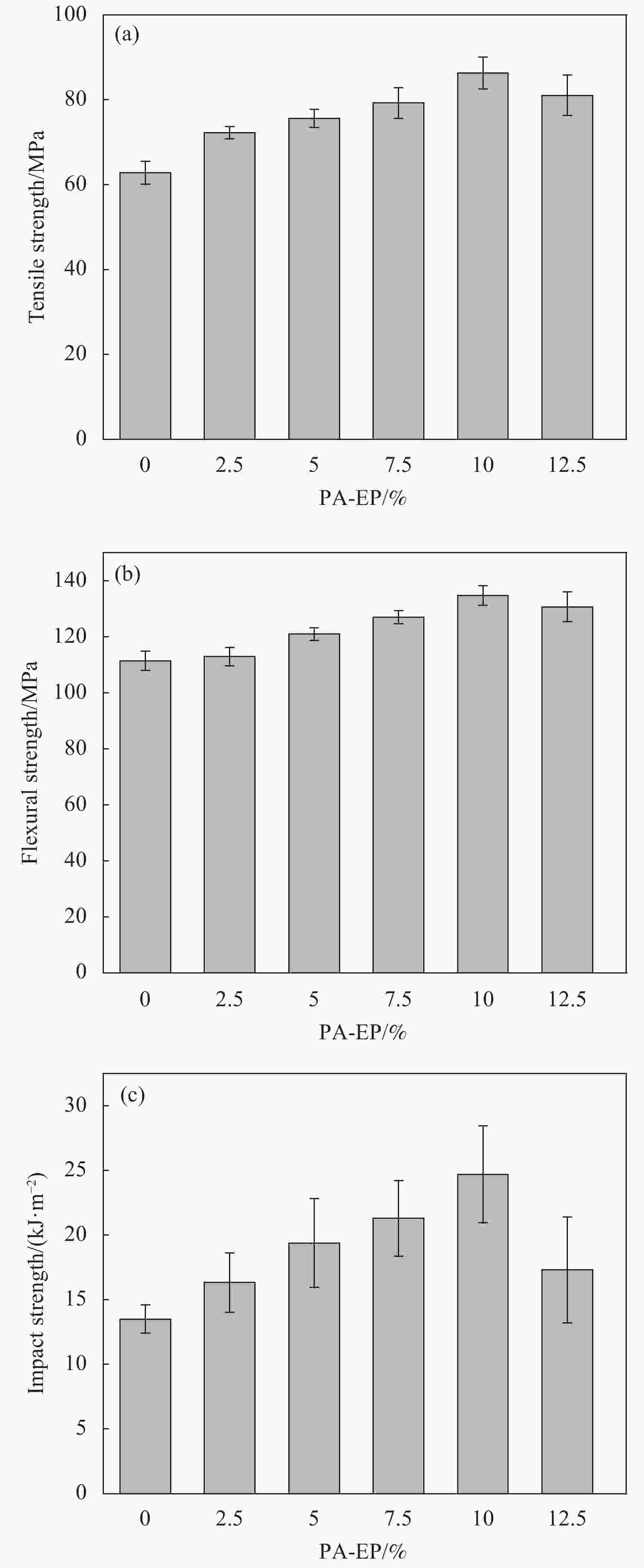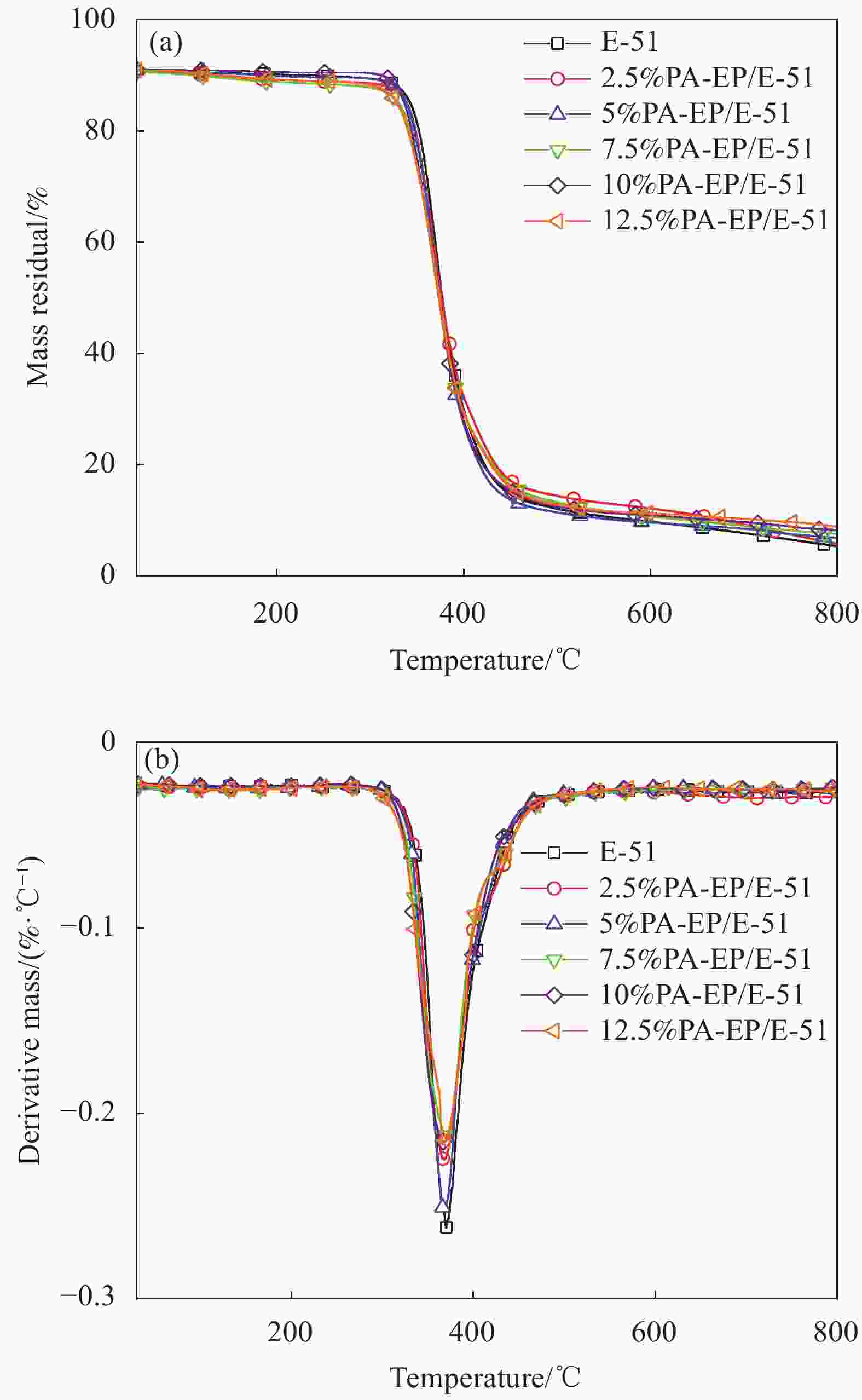Preparation and application of epoxy resin derived from protocatechuic acid
-
摘要: 环氧树脂质脆需要增韧才能满足应用要求,以天然原儿茶酸(Protocatechuic acid,PA)和环氧氯丙烷为原料,通过两步法反应合成原儿茶酸环氧树脂(PA-EP),并将其作为特种环氧树脂用于双酚A环氧树脂(E-51)的改性研究。采用傅里叶红外光谱仪(FTIR)、核磁共振(1HNMR)、电位滴定仪和黏度仪对产物进行结构表征和性能测试。FTIR和1HNMR分析表明成功合成目标产物,环氧值为0.73 eq/100 g,25℃下黏度为43.2 Pa·s。力学性能分析表明,当PA-EP与E-51质量比为10%时,PA-EP/E-51固化物的力学性能最佳,拉伸强度、弯曲强度和冲击强度比纯E-51分别提升了37.4%、17.2%和82.9%。冲击断面的扫描电子显微镜(SEM)结果表明,10%PA-EP/E-51固化物呈现良好的韧性断裂特征。动态机械分析(DMA)和热重分析(TG)结果表明,随着PA-EP含量的增加,固化物的玻璃化转变温度(Tg)由纯E-51的116.0℃提高到12.5%PA-EP/E-51的137.3℃,失重10%的温度和最大分解速率的温度都略微下降,但800℃残渣量由纯E-51的5.9%提高到12.5% PA-EP/E-51的9.8%。Abstract: The brittleness of epoxy resin needs toughening to meet the application requirements. Protocatechuic acid epoxy resin (PA-EP) was synthesized from protocatechuic acid (PA) and epichlorohydrin via two-step reaction, and used as special epoxy resin for the modification of bisphenol A epoxy resin. The structure and properties of the PA-EP were characterized by fourier transform infrared spectrometer (FTIR), nuclear magnetic resonance spectroscopy (1HNMR), potentiometric titration and viscosity tester. FTIR, 1HNMR and viscosity analyses indicate that the target product are synthesized with epoxy value of 0.73 eq/100 g and viscosity of 43.2 Pa·s at 25℃. The mechanical properties of PA-EP/E-51 thermosets are better than others when the mass ratio of PA-EP to E-51 is 10%. The tensile strength, flexural strength and impact strength are increased by 37.4%, 17.2% and 82.9%, respectively. The scanning electron microscope (SEM) images of impact section show that PA-EP/E-51 thermosets exhibit ductile fracture characteristics. Dynamic mechanical analysis (DMA) and thermogravimetry (TG) results indicate that the glass transition temperature (Tg) increases from 116.0℃ (neat E-51) to 137.3℃ with 12.5% of PA-EP/E-51. The weight loss 10% and the maximum decomposition rate temperature are decreased slightly while the residue content of 800℃ increases from 5.9% (neat E-51) to 9.8% (12.5% PA-EP/E-51).
-
Key words:
- protocatechuic acid /
- epoxy resin /
- mechanical properties /
- thermal properties /
- in situ toughening
-
表 1 PA-EP/E-51固化物的玻璃化转变温度Tg
Table 1. Glass transition temperature Tg of PA-EP/E-51 cured products
Sample Tg/℃ E-51 116.0 2.5%PA-EP/E-51 121.4 5%PA-EP/E-51 129.9 7.5%PA-EP/E-51 130.0 10%PA-EP/E-51 130.5 12.5%PA-EP/E-51 137.3 表 2 不同PA-EP质量比的PA-EP/E-51固化物热失重数据
Table 2. Thermogravimetric date of PA-EP/E-51 cured products with different PA-EP mass ratios
Sample T10%/℃ Tmax/℃ Residual mass/% E-51 349.5 370.1 5.9 2.5%PA-EP/E-51 345.9 368.0 6.3 5%PA-EP/E-51 344.8 367.5 7.6 7.5%PA-EP/E-51 343.3 369.4 8.4 10%PA-EP/E-51 341.9 367.1 9.1 12.5%PA-EP/E-51 337.1 364.2 9.8 Notes:T10%—Temperature at which the weight loss rate of the cured substance is 10%; Tmax—Temperature at the maximum decomposition rate. -
[1] LIU X F, LIU B W, LUO X, et al. A novel phosphorus-containing semi-aromatic polyester toward flame retardancy and enhanced mechanical properties of epoxy resin[J]. Chemical Engineering Journal,2020,380:122471. [2] FENG A L, HOU T Q, JIA Z R, et al. Preparation and characterization of epoxy resin filled with Ti3C2Tx MXene nanosheets with excellent electric conductiity[J]. Nanomaterials,2020,10(1):162. doi: 10.3390/nano10010162 [3] AUVERGNE R, CAILLOL S, DAVID G, et al. Biobased thermosetting epoxy: Present and future[J]. Chemical Reviews,2014,114(2):1082-1115. doi: 10.1021/cr3001274 [4] YOURDKHANI M, HUBERT P. A systematic study on dispersion stability of carbon nanotube-modified epoxy resins[J]. Carbon,2015,81:251-259. doi: 10.1016/j.carbon.2014.09.056 [5] HAMERTON I, MCNAMARA L T, HOWLIN B J, et al. Toughening mechanisms in aromatic polybenzoxazines using thermoplastic oligomers and telechelics[J]. Macromolecules,2014,47(6):1946-1958. [6] VIJAYAN P P, HARIKRISHNAN M G, PUGLIA D, et al. Solvent uptake of liquid rubber toughened epoxy/clay nanocomposites[J]. Advances in Polymer Technology,2016,35(1):1-7. [7] LI S P, WU Q S, ZHU H J, et al. Impact resistance enhancement by adding core-shell particle to epoxy resin modified with hyperbranched polymer[J]. Polymers,2017,9(12):684. doi: 10.3390/polym9120684 [8] ZHENG J Y, ZHANG X W, CAO J, et al. Behavior of epoxy resin filled with nano-SiO2 treated with a Eugenol epoxy silane[J]. Journal of Applied Polymer Science,2020,138(14):50138. [9] MA S Q, LIU X Q, JIANG Y H, et al. Bio-based epoxy resin from itaconic acid and its thermosets cured with anhydride and comonomers[J]. Green Chemistry,2013,15:245-254. doi: 10.1039/C2GC36715G [10] TAKASHI T, KOHEI T, HIROSHI U. Bio-based epoxy resins from epoxidized plant oils and their shape memory behaviors[J]. Journal of the American Oil Chemists’ Society,2016,93(12):1663-1669. doi: 10.1007/s11746-016-2907-5 [11] XIN J N, LI M, LI R, et al. Green epoxy resin system based on lignin and tung oil and its application in epoxy asphalt[J]. ACS Sustainable Chemistry & Engineering,2016,4:2754-2761. [12] 胡芳芳. 柔韧型桐油基环氧热固单体的制备及其结构与性能的调控[D]. 北京: 中国林业科学研究院, 2019.HU Fangfang. Preparation and regulation of structure and properties of flexible tung-oil-based epoxy thermosetting monomers[D]. Beijing: Chinese Academy of Forestry, 2019(in Chinese). [13] NIKAFSHAR S, ZABIHI O, HAMIDI S, et al. A renewable bio-based epoxy resin with improved mechanical performance that can compete with DGEBA[J]. RSC Advances,2017,7(14):8694-8701. doi: 10.1039/C6RA27283E [14] NILOY B, DUA T K, RITU K, et al. Protocatechuic acid, a phenolic from sansevieria roxburghiana leaves, suppresses diabetic cardiomyopathy via stimulating glucose metabolism, ameliorating oxidative stress, and inhibiting inflammation[J]. Frontiers in Pharmacology,2017,8:251. doi: 10.3389/fphar.2017.00251 [15] YOSWARIS S, PATCHAREEWAN P, CHATTIPAKORN S C, et al. Pharmacological properties of protocatechuic acid and its potential roles as complementary medicine[J]. Evidence-Based Complementray and Alternative Medicine,2015,2015:593902. [16] CHEN X R, HOU J R, GU Q, et al. A non-bisphenol-A epoxy resin with high Tg derived from the bio-based protocatechuic acid: Synthesis and properties[J]. Polymer,2020,195:122443. doi: 10.1016/j.polymer.2020.122443 [17] TAO Y Q, FANG L X, DAI M L, et al. Sustainable alternative to bisphenol A epoxy resin: High-performance recyclable epoxy vitrimers derived from protocatechuic acid[J]. Polymer Chemistry,2020,11:4500. doi: 10.1039/D0PY00545B [18] 中国国家标准化管理委员会. 树脂浇铸体性能试验方法: GB/T 2567—2008 [S]. 北京: 中国标准出版社, 2008.Standardization Administration of the People’s Republic of China. Test methods for properties of resin casting boby: GB/T 2567—2008 [S]. Beijing: China Standards Press, 2008(in Chinese). [19] 中国国家标准化管理委员会. 塑料 环氧化合物 环氧当量的测定: GB/T 4612—2008 [S]. 北京: 中国标准出版社, 2008Standardization Administration of the People’s Republic of China. Plastics-epoxy compounds determination of epoxy equivalent: GB/T 4612—2008 [S]. Beijing: China Standards Press, 2008(in Chinese). [20] 中国国家标准化管理委员会. 塑料 环氧树脂 黏度测定方法: GB/T 22314—2008 [S]. 北京: 中国标准出版社, 2008Standardization Administration of the People’s Republic of China. Plastics-epoxide resins-determination of viscosity: GB/T 22314—2008 [S]. Beijing: China Standards Press, 2008(in Chinese). [21] JIANG H, SUN L, ZHANG Y R, et al. Novel biobased epoxy resin thermosets derived from eugenol and vanillin[J]. Polymer Degradation and Stability,2019,160:45-52. doi: 10.1016/j.polymdegradstab.2018.12.007 [22] 李庆. 反应诱导相分离增韧双酚A环氧树脂交联网络的制备及性能研究[D]. 北京: 北京化工大学, 2019.LI Qing. Preparation and properties of reaction-induced phase separation toughtened bisphenol A epoxy resin crosslinking network[D]. Beijing: Beijing University of Chemical Technology, 2019(in Chinese). [23] JIN X L, LI W Z, LIU Y Y, et al. Self-constructing thermal conductive filler network via reaction-induced phase separation in BNNSs/epoxy/polyetherimide composites[J]. Composites Part A: Applied Science and Manufacturing,2020,130:105727. doi: 10.1016/j.compositesa.2019.105727 [24] HU D, ZHENG S X. Reaction-induced microphase separation in epoxy resin containing polystyrene-block-poly(ethylene oxide) alternating multiblock copolymer[J]. European Polymer Journal,2009,45(12):3326-3338. [25] WANG S, MA S Q, XU C X, et al. Vanillin-derived high-performance flame retardant epoxy resins: Facile synthesis and properties[J]. Macromolecules,2017,50(5):1892-1901. doi: 10.1021/acs.macromol.7b00097 [26] SHANG L, ZHANG X P, ZHANG M J, et al. A highly active bio-based epoxy resin with multi-functional group: Synthesis, characterization, curing and properties[J]. Journal of Materials Science,2018,53:5402-5417. doi: 10.1007/s10853-017-1797-8 [27] 王一鸣. 基于刚性单体的生物基环氧复合材料的制备及其性能研究[D]. 石家庄: 石家庄铁道大学, 2020.WANG Y M. Preparation and properties of bio-based epoxy composites based on rigid monomers[D]. Shijiazhuang: Shijiazhuang Tiedao University, 2020(in Chinese). [28] 尚垒. 基于白藜芦醇的生物基环氧树脂合成、固化及其碳纤维复合材料性能研究[D]. 长春: 长春工业大学, 2018.SHANG Lei. Synthesis, curing and properties of bio-epoxy resin based on resveratrol and carbon fiber composites[D]. Changchun: Changchun University of Technology, 2018(in Chinese). [29] ZHANG T T, TAN J H, HAN X, et al. Novel epoxy-ended hyperbranched polyether derived from xylitol as sustainable tougheners for epoxy resin[J]. Polymer Testing,2021,94:107053. doi: 10.1016/j.polymertesting.2021.107053 [30] YU M, FU Q H, ZHANG T T, et al. Properties and curing kinetics of epoxy resin toughened by dimer acid diglycidyl ester[J]. Thermochimica Acta,2021,699:178910. doi: 10.1016/j.tca.2021.178910 [31] ZHAO Q, WANG X Y, HU Y H. The application of highly soluble amine-terminated aromatic polyimides with pendent tert-butyl groups as a tougher for epoxy resin[J]. Chinese Journal of Polymer Science,2015,33(10):1359-1372. doi: 10.1007/s10118-015-1685-0 [32] LIU T, NIE Y, CHEN R, et al. Hyperbranched polyether as an all-purpose epoxy modifier: controlled synthesis and toughening mechanisms[J]. Journal of Materials Chemistry A,2014,3(3):1188-1198. [33] TOMUTA A, FERRANDO F, SERRA A, et al. New aromatic–aliphatic hyperbranched polyesters with vinylic end groups of different length as modifiers of epoxy/anhydride thermosets[J]. Reactive & Functional Polymers,2012,72(9):556-563. [34] JIN Q F, MISASI J M, WIGGINS J S, et al. Simultaneous reinforcement and toughness improvement in an aromatic epoxy network with an aliphatic hyperbranched epoxy modifier[J]. Polymer,2015,73:174-182. doi: 10.1016/j.polymer.2015.07.031 [35] FEI X M, TANG Y Y, WEI W, et al. One-pot synthesis of tetramethyl biphenyl backboned hyperbranched epoxy resin as an efficient toughening modifier for two epoxy curing systems[J]. Polymer Bulletin,2018,75:4571-4586. -






 下载:
下载:
